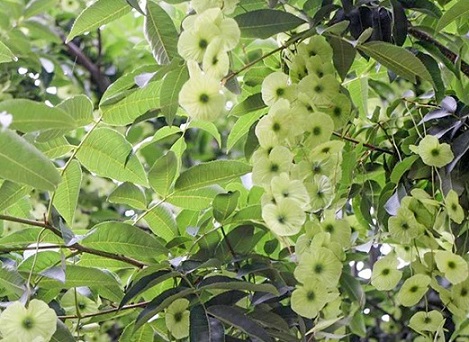Herbs And Phytochemicals: Flavonoids From Cyclocarya Paliurus Can Treat Diabetes Via PIK3CA And By Promoting Beta-TC-6 Cell Proliferation
Nikhil Prasad Fact checked by:Thailand Medical News Team Jan 29, 2024 1 year, 10 months, 3 weeks, 6 days, 2 hours, 25 minutes ago
Herbs And Phytochemicals: Diabetes mellitus (DM), a chronic inflammatory disease with severe health implications, affects millions globally. Current treatments involve oral antidiabetic drugs, but their associated side effects necessitate the exploration of alternative, safe, and effective interventions. Traditional Chinese medicine (TCM) has a rich history in DM treatment, with recent attention focusing on flavonoids due to their safety and efficacy. This
Herbs And Phytochemicals news report delves into a groundbreaking study conducted by researchers from Zhejiang Sci-Tech University and Taizhou University, China, on the antidiabetic effects and underlying mechanisms of Cyclocarya paliurus (C. paliurus) leaf flavonoids, providing a novel perspective on treating type II diabetes mellitus (T2DM).
 Cyclocarya Paliurus
Cyclocarya Paliurus: A Novel Functional Food Resource
Cyclocarya Paliurus
Cyclocarya Paliurus: A Novel Functional Food Resource
C. paliurus, a member of the Pecanaceae family, is extensively found in southern China and has been used as a health food for over a millennium. Its leaves, approved as a novel food resource, contain polysaccharides, flavonoids, and terpenoids known for their therapeutic effects in DM. Notably, the total flavonoids of C. paliurus (CTFs) have demonstrated prebiotic-like activity and potential in preventing obesity-related metabolic disorders. Despite these benefits, the specific targets and mechanisms of CTFs in vitro, at the cellular level, remain unexplored.
Experimental Approach
The study employed a multidimensional approach, integrating in vitro experiments, transcriptomic analysis, network pharmacology, and biolayer interferometry (BLI) to comprehensively investigate the effects of CTFs on beta-TC-6 cells and elucidate the underlying mechanisms. The researchers identified nine flavonoids within CTFs, including velutin, kaempferide, peonidin, apigenin, pelargonidin, 5,6,7-trihydroxyflavone, tangeretin, laricitrin, and 4'-methylnaringenin, which exhibited antidiabetic effects.
Chemical Characterization of CTFs
The chemical composition of CTFs was analyzed, revealing three flavonoid C-glycosides, 35 flavonoid O-glycosides, and five flavonoid aglycones. Notably, 14 flavonoid aglycones, such as 4'-methylnaringenin, apigenin, and kaempferol, were identified.
In Vitro Effects of CTFs on Beta-TC-6 Cells
In vitro experiments demonstrated that CTFs within a certain concentration range were not toxic to beta-TC-6 cells. High glucose-induced damage to these cells was mitigated by CTF treatment, leading to a dose-dependent recovery of insulin mRNA expression. Furthermore, CTF treatment significantly promoted the proliferation of beta-TC-6 cells, indicating its potential in treating DM.
Comparative Transcriptomic Analysis
Transcriptomic analysis revealed 1246 differentially expressed genes (DEGs) between CTF-treated and untreated beta-TC-6 cells. Gene ontology (GO) analysis highlighted biological processes related to oxidat
ive phosphorylation, electron transport chain, and ATP synthesis–coupled electron transport. Key pathways such as the PI3K-AKT signaling pathway, insulin secretion pathway, insulin signaling pathway, and p53 signaling pathway were enriched, emphasizing their role in glucose uptake, insulin expression, and cell proliferation.
Network Pharmacology Insights
Network pharmacology was employed to predict key target proteins of CTFs in diabetes treatment. A component–target–pathway network consisting of 165 nodes and 3823 edges was established, revealing 45 chemical components interacting with 47 protein targets through 73 pathways. Notably, PIK3CA, PIK3R1, PIK3CG, PIK3CD, AKT1, IGF1R, and GSK3B emerged as key target proteins, participating in pathways crucial for diabetes treatment.
Molecular Docking Validation
Molecular docking validated the interactions between the identified flavonoids and key target proteins, reaffirming the potential of velutin, kaempferide, peonidin, apigenin, pelargonidin, 5,6,7-trihydroxyflavone, tangeretin, laricitrin, and 4'-methylnaringenin in treating diabetes. The lowest binding energy was observed between PIK3CA and the flavonoids, suggesting their strong binding affinity.
Biolayer Interferometry Analysis
Biolayer interferometry analysis further confirmed the direct interaction between PIK3CA and specific flavonoids. Kaempferide, peonidin, pelargonidin, and 4'-methylnaringenin exhibited significant binding affinity with PIK3CA, reinforcing their role in the antidiabetic effects of CTFs.
Discussion on Results
The study's findings provide robust evidence supporting the antidiabetic effects of CTFs in promoting insulin expression and beta-cell proliferation while mitigating abnormal glucose metabolism. Transcriptomic analysis highlighted the involvement of key genes in pathways crucial for diabetes development, emphasizing the impact of CTFs on cell survival, insulin secretion, and signaling.
Network pharmacology unveiled key target proteins and pathways, aligning with transcriptomic analysis results. PIK3CA, PIK3R1, PIK3CG, PIK3CD, AKT1, IGF1R, and GSK3B were identified as central players in the antidiabetic effects of CTFs, participating in pathways related to insulin signaling, PI3K-AKT signaling, and TNF signaling.
The chemical characterization of CTFs, in conjunction with in vitro experiments, emphasized the safety and effectiveness of the identified flavonoids. Molecular docking and BLI analyses validated the binding affinity of these flavonoids with key target proteins, corroborating their potential as therapeutic agents in diabetes treatment.
Conclusion
In conclusion, this comprehensive study sheds light on the therapeutic potential of Cyclocarya paliurus flavonoids in treating type II diabetes mellitus. The identified flavonoids within CTFs, including velutin, kaempferide, peonidin, apigenin, pelargonidin, 5,6,7-trihydroxyflavone, tangeretin, laricitrin, and 4'-methylnaringenin, exhibit significant antidiabetic effects by directly interacting with key target proteins like PIK3CA. The integration of transcriptomic analysis, network pharmacology, and molecular docking provides a holistic understanding of the mechanisms underlying CTFs' efficacy in diabetes treatment. Further in vitro and in vivo studies are warranted to unravel the full therapeutic potential and elucidate the intricate mechanisms of these flavonoids, paving the way for the development of novel and effective treatments for type II diabetes mellitus.
The study findings were published in the peer reviewed Journal of Functional Foods.
https://www.sciencedirect.com/science/article/pii/S1756464624000331
For the latest on
Herbs and Phytochemicals, keep on logging to Thailand Medical News.
